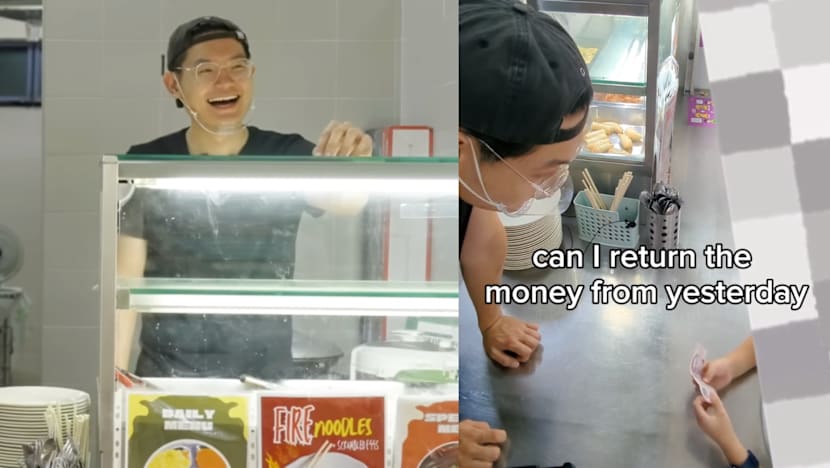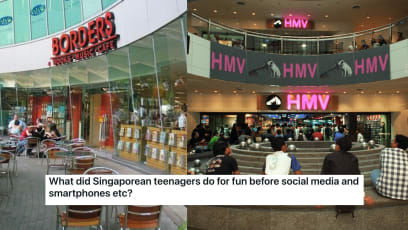Why This Gen Z Chose To Run A Canteen Stall At Mee Toh School Despite “Razor Thin” Profit Margins
For 27-year-old Rayner, running a school canteen business is a way for him to dabble in F&B without having to face high start-up costs.

You may have come across videos of a young school canteen vendor (@veg.eng) who’s gone viral for his wholesome interactions with students.
Rayner, a 27-year-old Gen Z Singaporean, runs a vegetarian stall at Mee Toh School, where he serves up dishes such as prata and curry, ramen, kimchi fried rice, and onigiri for S$2.50 and under.
Appearing on the latest episode of Gen Z Crash Course, Rayner told YES 933 DJ Chen Qijia about his motivation for being a canteen vendor while also giving her a glimpse into his daily work routine.
Rayner’s day typically begins at 5.30am. He goes to the supermarket to purchase ingredients, then heads to school where he starts to prepare for the day at 6am. He spends about an hour sanitising the area before whipping up meals for the students.
He’s been running the stall for five months now, and though the experience has been enjoyable, Rayner candidly reveals that his profit margins are “razor thin”.
“There’s a few reasons for that,” he explains. “Firstly, it’s because of the cost of ingredients. We can’t do economies of scale because we are only one stall, and we also have to meet the healthy plate requirements to have whole grains, vegetables, protein, things like that.”
He also has to factor in the cost of utilities, plus the fact that he’s required to keep his prices under S$2.50. As such, he makes less than S$1 for each plate of food he sells.
School canteens are closed during the holidays as well as weekends, and to deal with the lapse of income, Rayner also has a side hustle where he sells matcha drinks out of his home cafe.
Although he has an engineering degree, Rayner’s decision to become a canteen vendor stemmed from his interest in cooking.
He shares: “I just came back from a volunteering trip recently with my church. It was there where my passion for cooking grew. I was in Sapporo, Japan, and we did many events, and with every event we invited people and cooked for them, so we [prepared] Singaporean food like chicken rice and laksa.”
“It happened that two of the people I went with are primary school teachers, so I hear a lot about the primary school environment and school canteens, and they encouraged me to try it out. I also wanted to work with kids, so I decided to open an F&B stall,” he continues.
For Rayner, opening a canteen stall was a more practical option as the F&B industry is competitive, and rental is high.
“You need a huge capital to start, and coming back from volunteering, I didn’t have a huge capital, so schools became one of my best options because rental is low, and startup costs are also not that high,” he says.
By 2026, at least 13 local schools would have completely replaced their canteen vendors with central kitchens. This change has got Singaporeans lamenting the loss of an experience where they get to interact and form a bond with their canteen vendors, as well as the lack of options when it comes to their meals.
Joining Rayner and Qijia in their chat is experienced canteen vendor, Sally.
Sharing her take on the upcoming changes, she says: “I’ve spoken to parents, and for the students, they get to interact with school canteen vendors. They will understand the concept of money, such as the value of 10 cents and 20 cents. They [might not be able to learn that], and there will be a lack of interaction in ordering food, which is actually a very good chance for them to learn and grow.”
“I can’t speak much on the central kitchen, neither can I object to it, but I like the current arrangement at Mee Toh School. People here are like family, whether it is the student, the teacher, or other school staff, they treat each other with the closeness of family,” she adds.
Speaking on the challenges of running a canteen stall, Rayner also shares that the holiday periods are tough as stall owners are unable to run their business.
“Perhaps we can allow a more hybrid model where we stall vendors don’t just sell to the school, but also the public. So for example, from 2pm onwards, maybe [we] can switch up our menu and sell to the public through [food delivery] or pick-ups. I feel like that would help boost our income,” suggests Rayner.
“During the holidays, we could also consider allowing vendors to do catering events to utilise the space as well,” he says, adding that a more economically-feasible plan might, in turn, entice more Gen Zs to the career.
Watch the full episode of Gen Z Crash Course below to see how Rayner's day as a school canteen vendor is like.







![S’porean Gen Z Mum Of 3 Shares How She Copes Financially, And Why Being A Mum "Is [Her] True Identity" S’porean Gen Z Mum Of 3 Shares How She Copes Financially, And Why Being A Mum "Is [Her] True Identity"](https://dam.mediacorp.sg/image/upload/s--47cF_2h7--/c_fill,g_auto,h_230,w_408/f_auto,q_auto/v1/mediacorp/8days/image/2025/11/10/tiredgenzmum_main.jpg?itok=zHkc7DHa)






















